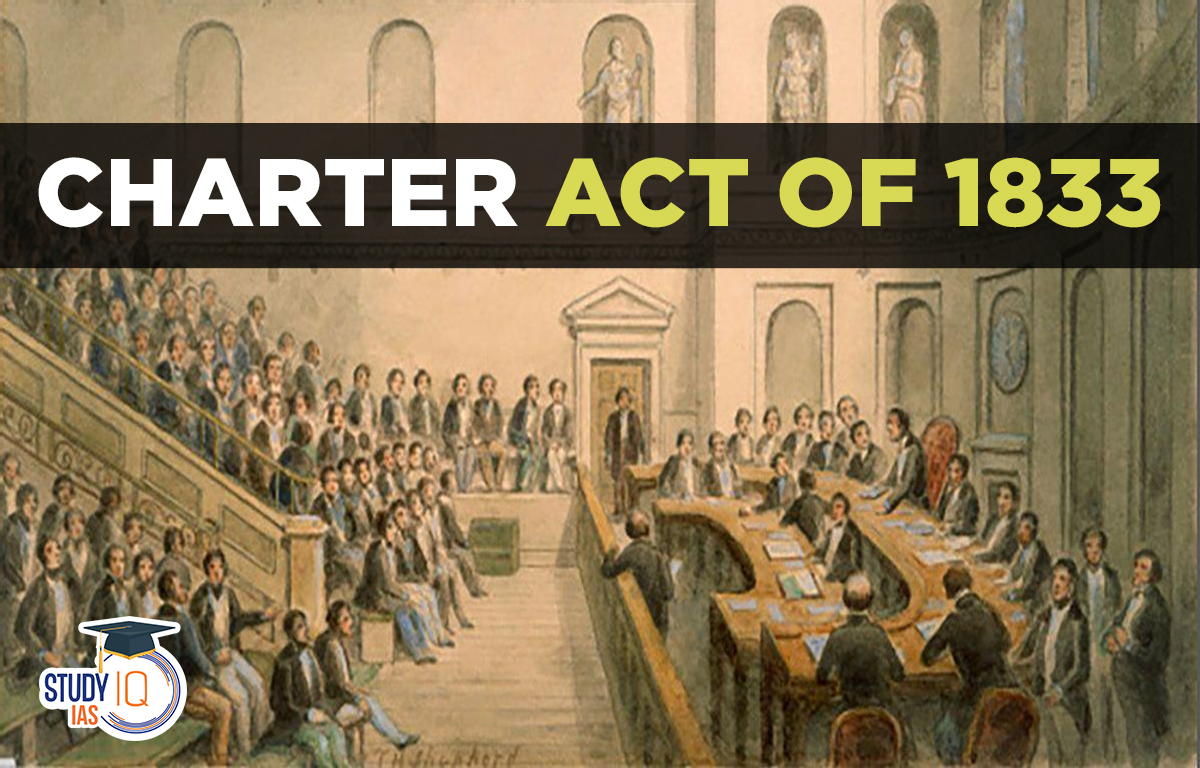Table of Contents
Charter Act of 1833
Charter Act of 1833 is extended charter of East India Company. The East India Company’s charter, which was due to expire at the end of 1833, was extended by 20 years by the Charter Act of 1833. The English East India Company lost control of the island of Saint Helena in the southwest Atlantic Ocean as a result of the United Kingdom Parliament’s Charter Act 1833, also known as the Government of India Act 1833 or the Saint Helena Act 1833.
The British Parliament passed the Charter Act of 1833 to update the East India Company’s Charter Act of 1813. This article goes into great length on the topic “Charter Act of 1833,” which is a significant component of the UPSC/IAS Exam Polity and Governance syllabus.
Read about: Lucknow Pact
The Charter Act of 1833 History
With the Industrial Revolution having had a considerable impact on Great Britain, the Charter Act of 1833 was passed against this backdrop. The laissez-faire philosophy was adopted as the government’s approach to the industrial enterprise. The outcome of the liberal movement was the Reform Act of 1832.
The parliament was urged in 1833 to renew the Charter in this era of freedom and change. The political climate in Britain was seeking changes and liberal ideas at the time the Charter Act of 1833 was being drafted. They concurred with Macaulay to maintain the corporate policy but on a different predicate.
The bill was introduced in the parliament, nevertheless, while the Whig party was in power and the legislature was in a reform-, free-trade-, and law-codification-friendly frame of mind. A watershed in India’s constitutional history was achieved with the passage of the Charter act of 1833, which followed the recommendations of a parliamentary enquiry.
Read about: Gandhi Irwin Pact
The Charter Act 1833 Provisions
Office of Governor-General
The bill was introduced in the parliament, nevertheless, while the Whig party was in power and the legislature was in a reform-, free-trade-, and law-codification-friendly frame of mind. A watershed in India’s constitutional history was achieved with the passage of the Charter act of 1833, which followed the recommendations of a parliamentary enquiry.
The Governor-General of India received both civil and military authority. The Government of India was constituted for the first time, having control over the entire area of India held by the British. Lord William Bentick was appointed as India’s first governor general.
Powers of Governor-Generals Council
Any laws or regulations enforced in British India could be repealed, amended, or changed by the Governor-General sitting on the council. Any time there is a disagreement over a topic in the Governor-General Counsels, the Governor-judgment General’s will be final, and he has the right to overrule the consensus. In cooperation with the councils, the governor-general oversaw civil, military, and revenue concerns.
The court of directors was granted the authority to veto any laws passed by the governor-general in the council, but the governor-general in the council was given the authority to repeal, alter, or amend any laws or regulations for all individuals in the British dominion of India. For the first time, the legislation called for the appointment of a fourth Governor-General Member to the council, who was only permitted to participate in meetings and cast votes when it came to passing laws.
Abolition of Commercial Privileges of the East India Company
The corporation abolished all of its trading privileges. This implies that the firm could no longer benefit from its monopoly on the trade of tea and goods from China that it had owing to the Charter Act of 1813. The business was given permission to keep its lands in the capacity of trustee for “His Majesty, his heirs, and successors.”
Legal British Colony
In accordance with the charter act of 1813, all limits placed on the immigration of Europeans and Britons were lifted. Now, Europeans and the British were allowed to buy, hold, and sell any property in India. They could now travel and live in India without restriction. India became a colony of the British.
Replacement of Board of Control as Minister for Indian Affairs
The Minister of Indian Affairs took over as the Board of Control’s president. The act had a clause that would have divided the president of Bengal to create the presidency of Agra and Fort William, but this clause was never implemented.
Financial Centralization
The statute also allowed for the centralization of financial resources. The capacity of presidential governments to raise money and spend it was constrained. All financial matters, including the generation of revenues and expenditures, were transferred to the Governor General-Council.
Formation of Law Commission
The charter act of 1833 marked the beginning of an attempt to codify laws. The Law Commission was to be appointed in accordance with Section 53 of the 1833 charter act. The Law Commission’s primary objective was to codify and harmonies Indian law.
The first Law Commission was established in 1834 as a first step in codifying laws. Lord Macaulay served as its chairman, while the other three members, J.M. Madeira, G.W. Anderson, and C.H. Cameron, represented the respective presidencies of Calcutta, Madras, and Bombay. The Penal Code draught, often known as the “Macaulay Code,” was presented to the government by the Law Commission in 1837.
However, the 1857 uprising meant that the draught couldn’t be fully implemented until 1860. The proposals led to the introduction of the code of civil procedure in 1859, the Indian penal code in 1860, and the criminal procedure code in 1862.
Attempt to Open Civil Services on the Basis of System of Merit
The act eliminated barriers based on religion, race, caste, and creed and allowed for Indians’ unrestricted involvement in the nation’s governance. It has reduced selection criteria to one: merit. The first law that made it possible for Indian nationals to openly partake in the country’s government was the Charter Act of 1833.
The act has given the Court of Directors the authority to nominate through a competitive examination 4 times as many candidates each year as there are open positions. It was an attempt to implement an open competition system for the civil service. However, this open competition approach did not perform well in the near future.
Abolition of Slavery
The ordinance also called for a reduction in slavery that still existed in British India. It was mandated that the Governor General-in-Council take action to put an end to the widespread slavery in India. In India, slavery was outlawed by Act V of 1843.
Increase in no of Bishops
With the passage of the Act of 1833, there were now three bishops, and the Bishop of Calcutta was appointed Metropolitan Bishop of India.
The Charter Act 1833 Significance
This deed opened the ground for British India to be unified and for a powerful central government to be established there. The act made provisions for the codification of the laws and disregarded the strict criteria for exclusion from participation in national administration.
A significant step toward consolidating and centralizing India’s administration was the promotion of the Governor General of Bengal to Governor General of India. This law gave Indian nationals the freedom to participate in county government without hindrance based on their race, ethnicity, religion, or other characteristics.
For the first time, the Governor General’s legislative and executive responsibilities in the Council were divided. The codification of laws was also very important.
The Charter Act 1833 Drawbacks
The job of the government-in-council was so heavily burdened by the over-centralization that he was unable to give the time and attention necessary to broad concerns of principles or matters of public interest. Because there was no presidencies representative in the supreme council, the government was unable to address the needs, urgency, and demands of the local government.
The presidencies gradually became dissatisfied with the situation and showed little interest in the laws and policies the Supreme Council had put in place. It was challenging for the Governor General-in-Council to exert effective authority over remote presidencies as the central government was founded in Calcutta, in part due to the absence of efficient communication tools at the time. The Governor-General held all the power, making him or her extremely powerful and occasionally acting like an authoritarian.
Charter Act of 1833 UPSC
The British government passed a number of Acts to increase the scope of its authority in India, one of which was the Charter Act of 1833. The pre-independence Indian political system was impacted by the Act’s provisions. The British crown progressively took over the East India Company administration of India when the Charter Acts of 1833 were passed. The Charter Act of 1833 is fully explained in this article for UPSC exam preparation.


 Birsa Munda Birth Anniversary 2025: Life...
Birsa Munda Birth Anniversary 2025: Life...
 Military Innovations of Afghans and Turk...
Military Innovations of Afghans and Turk...
 Self-Respect Movement, History, Objectiv...
Self-Respect Movement, History, Objectiv...

























